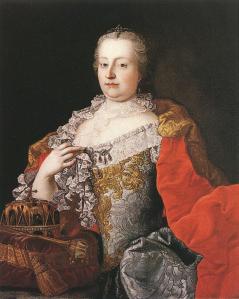Maria Theresa (1717-1780)
 Archduchess of Austria, Holy Roman Empress, and queen of Hungary and Bohemia, began her rule in 1740. She was the only woman ruler in the 650 history of the Habsburg dynasty. She was also one of the most successful Habsburg rulers, male or female, while bearing sixteen children between 1738 and 1756.
Archduchess of Austria, Holy Roman Empress, and queen of Hungary and Bohemia, began her rule in 1740. She was the only woman ruler in the 650 history of the Habsburg dynasty. She was also one of the most successful Habsburg rulers, male or female, while bearing sixteen children between 1738 and 1756.
Maria Theresa was the eldest daughter of Holy Roman Emperor Charles VI. In 1711, Charles VI found himself the sole remaining male Habsburg. An old European law, the Salic Law, prohibited a woman from inheriting her father’s kingdom. Concerned that he may not father a son, Charles VI issued a decree in 1713, known as the Pragmatic Sanction. This document guaranteed the right of succession to his daughter. At this time, many of the great powers of Europe agreed to her succession of power, at a price. Upon the death of Charles VI in 1740, however, challenges to the Habsburg lands led to the War of the Austrian Succession.
During the last several years of her father’s reign, two wars had already left the monarchy financially compromised, and the army weakened. And since Charles VI had believed that his daughter would surrender true power to her husband, Francis Stephen of Lorraine, he did not take the time to teach her the workings of the government. Without money, a strong army, and knowledge of state affairs, Maria Theresa knew she had to rely on her judgment and strength of character.
King Frederick II of Prussia was her first challenger, when he took the occasion of Charles VI’s death to occupy Silesia, beginning the War of Austrian Succession (1740-1748). Bavaria and France joined in and invaded Maria Theresa’s lands from the west. This challenge by Frederick II became the dominating element of Maria Theresa’s long reign. The archduchess was determined that her internal and external policies would focus on the strengthening of her state and the creation of positive diplomacy in order to defeat the Prussian monarch. Maria Theresa was determined not to surrender to her enemies, but to reconquer all of her lands. She began by initiating reforms. Maria Theresa strengthened the army by doubling the number of troops from her father’s reign, reorganized the tax structure to insure a predictable annual income to support the costs of the government and army, and centralized an office to assist in the collection of the taxes. Economic reform fueled prosperity for her empire. The war ended with the loss of Silesia, but her state intact, and her husband recognized as Holy Roman Emperor.
In 1756, Maria Theresa felt that Austria was strong enough to renew her conflict with Frederick II. With the direction of her state chancellor, Wenzel Anton von Kaunitz, the empress reorganized Austria’s foreign policy in the so-called Diplomatic Revolution.” On the advice of Kaunitz, Maria Theresa abandoned its accord with Great Britain and secured an alliance with France and Russia. Yet, Frederick II surprised everyone when he attacked first, invading one of Austria’s allies, Saxony. This conflict began what is known as the Seven Years’ War (which combined with the French & Indian war in the American Colonies). In 1763, after much bloodshed, Maria Theresa signed the Treaty of Hubertusberg, ending all hostilities and recognizing Prussian possession of Silesia once and for all.
Two years later, Maria Theresa suffered a great personal loss, the unexpected death of her husband, Francis Stephen of Lorraine. Her love for him was so deep that from the day of his death until her own death in 1780, she dressed in mourning. After Francis Stephen’s death, Maria Theresa became increasingly withdrawn. She continued reforms, but they came at a slower and more systematic pace. She changed her foreign policy from vigorously trying to regain Silesia to maintaining peace. After fifteen years of war and frustration, Maria Theresa was reluctant to get involved in conflicts that might prove unsuccessful. After the death of Francis Stephen, Maria Theresa recognized the eldest of her sixteen children, Joseph II, as emperor and coregent. Joseph II’s many fundamental differences in beliefs with his mother, caused anxiety and arguments. Periodically, Maria Theresa considered abdication of the throne. However, she never did abdicate. Instead, she allowed Joseph II only limited powers, since she felt his judgment too rash.
Maria Theresa was courageous, generous and kind. She respected the rights of others and expected others to respect her rights. In the later part of her rule, the empress focused more on human concerns, and less on financial and administrative improvements. She became increasingly involved with the problem of serf reform. Throughout the empire, the peasants were obligated to pay monetary and work dues to their lords. In 1771, Maria Theresa issued the Robot Patent, the serf reform designed to regulate the peasants’ labor payments in all of the Habsburg lands.
The empress had a long reign which spanned forty years. She died on November 29, 1780. Some historians have termed Maria Theresa as the savior of the Habsburg Dynasty. Her efforts to transform her empire into a modern state solidified the Habsburg rule. Although when she came to the throne, her state appeared on the brink of dismemberment, Maria Theresa provided a strong foundation for the continuation of the Habsburg Dynasty into the modern era.
http://departments.kings.edu/womens_history/mariatheres.html
Leave a comment